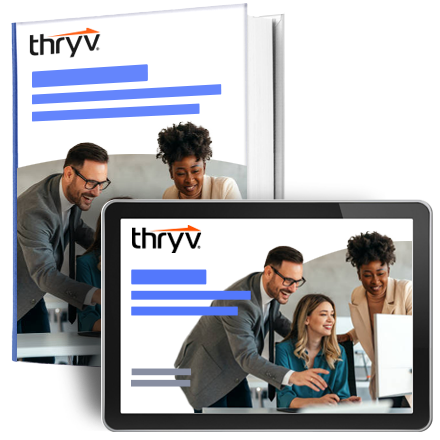Advertising is essential for any business – but it’s particularly important for small businesses that work with a smaller budget. You need to get the most out of your advertising campaigns and maximize the return on your investment.

We’re sharing our expert tips to help you boost productivity, eliminate time-wasting tasks, and more in this free guide.
Download Now
This post will break down six essential advertising tips for small business owners. We’ll discuss different strategies you should use and the tools to help you implement each one. By the end of this post, you’ll have a series of proven techniques to craft effective advertising campaigns.
6 Advertising Tips for Small Business Owners
Here are six tips for advertising a small business and the tools you’ll need for each.
1. Use online and offline advertising strategies.
Online advertising is one of the most effective ways to reach new customers. Almost everyone uses the internet, and you can market your business online in dozens of ways.
But you shouldn’t confine yourself to one space. Small business owners should use a balance of both online and offline marketing strategies because it keeps your brand relevant even when customers aren’t online. Offline advertising includes things like print ads, TV commercials, event marketing, and more.
How to Do This:
The best way to craft your advertising strategy is to consider how content can be reused. For instance, if you shoot a TV commercial, that video can be repurposed for social media. You could post it on YouTube or create a paid ad for Facebook or Instagram. Rather than having to shoot two different videos, double up on your investment and reuse content for both online and offline channels.
What You’ll Need:
Here’s what you’ll need to market your business online:
- Social Media: Social media platforms are great for creating paid and unpaid ads (more on this later).
- Ad Platform: Platforms like Google Ads help you create paid advertisements on search engines, other websites, YouTube, and more. They also have reporting tools that measure the performance of your ads.
- Customer Database (CRM): A CRM tracks customer engagement and records interactions with your business. That data is stored on individual contact profiles that you can use for future campaigns.
Here’s what you’ll need to market your business offline:
- Graphic & Video Design: You’ll need software like Canva or Adobe InDesign to create visual content for your advertisements. Alternatively, you can outsource this work to a graphic designer.
- Offline Tracking: These reports help you track the performance of your offline advertisements. They use call tracking and other features to measure the effectiveness of your offline campaigns.
- Appointment-Booking Software: If you’re hosting events, you’ll need appointment-booking software to keep track of attendees. These tools make registering for events easy and can also accept customer payments.
2. Create different types of social media ads.
Social media is one of the best places to advertise because the average person spends more than 2 hours a day on it. You just have to find channels your customers use and create ads to engage them.
Here are some places where you can pay to advertise on social media:
- TikTok
- YouTube
- X (Twitter)
- Snapchat
Unlike a free social media post, which allows only your followers to see your messages, a paid social ad helps you reach new audiences. You can target specific groups and control who sees your ad and when. Social ads are great for connecting with new customers who may not recognize your brand.
How to Do This:
Most social media sites require a business account to create ads. Fortunately, most sites also let you switch for free if you have a personal account. A few sites, like YouTube and Reddit, don’t require a business account.
Once you have your accounts set up, you can start creating ads. The built-in advertising tools help you set a budget, create content, and test different advertisements. Most sites have a range of ad types you can choose from, such as videos, carousels, polls, and more. When creating an ad campaign, test different formats, messages, and images to see what works best for your brand.
What You’ll Need:
Here’s what you’ll need to advertise on social media:
- Social Media Management Tools: These tools connect your social accounts together. That way, you’re not jumping between apps when you want to post new content or respond to comments. They also can track the effectiveness of your campaigns and the channels that perform best with your audience.
- Business Accounts: Most social media sites only allow business accounts to create ads. If you have a personal account, you can switch it to a business one for free.
3. Try search engine marketing.
Search engine marketing means advertising on sites like Google, Yahoo, and Bing. When people search for different phrases, your ad appears based on their search. Here’s an example:
Search engine marketing is a popular advertising strategy because most people discover new businesses through Google. Search ads engage customers when they’re thinking about buying something by putting your business at the top of their search results.
How to Do This:
If you want to advertise on search engines, you’ll need an ads account for your business. Google Ads is a great example. With a Google Ads account, you can create one-of-a-kind advertisements and conduct keyword research to see what your customers are searching for.
Google Ads will help you set a budget, choose your marketing channels, and test different advertisements to see which perform best. With Google Ads, you can advertise on search results, YouTube, Gmail, and more.
Here’s how it works. First, you determine which search phrases you want to advertise for. Then, create your ads and set a budget. Afterward, Google will automatically bid on ad space based on your budget and preferences. You’ll bid against other businesses to advertise on different keywords; the more popular the keyword is, the more expensive it is to advertise on it.
What You’ll Need
Here’s what you’ll need to do search engine marketing at your business:
- Ads Account: You’ll need an ads account on different search engines. Fortunately, a Google Ads account is free; you only pay when you win an ad auction.
- SEO Tools: SEO stands for search engine optimization. In other words, it’s the process of researching your customers’ search habits and creating content that performs well on search engines. SEO tools help you do just that.
4. Consider broadcast advertisements.
Broadcast advertisements are a more traditional form of advertising for small businesses. Things like TV commercials, radio ads, and podcast sponsorships fall into this category. They’re effective because they grow brand awareness and teach customers about your products, services, and deals.
How to Do This:
Like with any advertisement, start with a goal. What is the main message that you want to convey? Some businesses might advertise a deal. Others might announce a new product or a seasonal marketing campaign. Ensure this goal is clear and present in your messages so customers know exactly what you’re advertising.
You’ll also need production equipment to create your ad. If it’s within your budget, hire a production crew to help you record, edit, and optimize your commercial. This hire will be worth it if you have no production experience.
The last step is picking a channel to air your ad. You could use a local TV station or partner with streaming services to run targeted ads. Targeted ads are commercials shown to specific groups of people based on their interests, location, demographics, and behaviors.
Tip: Check out these local video marketing tips for more information about broadcast advertising.
What You’ll Need
Here’s what you’ll need to record broadcast advertisements for your business:
- Production Equipment: If you have the budget, invest in production tools like cameras, editing software, lights, etc. If that’s not possible, consider free tools like Canva, iMovie, and Veed.io instead.
- Campaign Tracking: If you’re going to spend money advertising, you should have a way to track your performance. Here, you might use offline tracking software to monitor phone calls, website traffic, and sales generated from commercials.
5. Test a series of display ads.
Display ads are advertisements shown on other websites. For example, a display ad for Mint Mobile aired on my personal website.
Like search ads, display ads are chosen based on customer behavior — particularly search history. When people search for certain terms or look at different websites, display ads are shown based on those actions.
How to Do This:
To create display ads, you’ll need a Google Ads account. Google has what’s called the “Google Display Network,” which features millions of websites that support display ads.
From there, you’ll choose your ad type (image, banner, video, etc.) and create an advertisement. Then, you’ll set a budget, and Google’s AI assistant will help you bid on ad space. You pay Google when someone clicks on your ad, or a certain number of people see it.
Here are a few resources that can help you get the most out of your display ads:
- How to Get the Most Out of Your Display Ads
- Getting Started With Display Ads
- FAQ – Display Advertising & Small Business
What You’ll Need
Here’s what you’ll need to create display ads for your business:
- Google Ads Account: You can create display ads from your Google Ads account. Just select the “Display” option as your campaign type (example below).
6. Invest in your unpaid strategies.
While paid advertisements help you reach new audiences, unpaid ads can forge stronger connections with your existing customers. Unpaid ads include social media posts, blogs, and online listings for your brand. You don’t have to pay to create them, and they can be just as effective as traditional advertising.
Here are a few ideas for unpaid advertising campaigns:
- Websites Pages
- Blogs
- Online Listings
- Social Media Posts
- Word-Of-Mouth Marketing
How to Do This:
I recommend creating a content calendar if you want to invest more in unpaid advertising strategies. A calendar will help you plan every piece of content for the next week, month, quarter, etc. Our team uses a content calendar, and it’s a great way to keep track of production on all your marketing channels.
Here’s what a content calendar might look like.
In this example, you’ll see that each type of content is categorized by a different color, with a due date for everything we post. This keeps you more organized and holds you more accountable when managing your ad campaigns.
What You’ll Need:
Here’s what you’ll need to create unpaid advertising campaigns at your business:
- Business Website: A website is like a digital home for your brand. It’s a great place to teach people about your products and services and promote your latest deals. You can even create landing pages that help you get organically discovered on Google.
- Enhanced Local Listings: Local listings are profiles that appear on sites like Yelp, Google Business, Angi, and more. A local listings management tool helps you update and manage your listings from one place.
- Online Reputation Management: Reputation management is how you react and respond to customer comments online (or offline). It’s incredibly important because review sites and social media platforms have customer ratings for your brand. If your rating is poor, fewer people will want to do business with you, and your business will appear less in search results.
Tip: Try this free online presence scanner to see what customers are saying about your business.
Advertisements for Small Businesses
Creating an effective advertising strategy doesn’t happen overnight. You need to test different ad types, formats, and marketing channels to see what performs best with your customers. Use the tips in this post to get started, and check out some of the tools on our website that can help you create effective small business campaigns.






